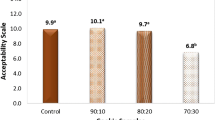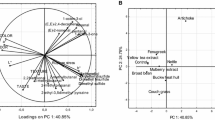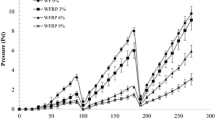Abstract
Cookies are baked at elevated temperatures to obtain a desirable browning and flavor development, which are provided by Maillard reaction and caramelization. The drawback here is the formation of α-dicarbonyl compounds, and they are associated with many metabolic disorders besides involving in the development of the desired flavor and browning. Cookies are one of the major sources of α-dicarbonyl compounds in diet. This study was performed to evaluate the formation of α-dicarbonyl compounds in cookies prepared from different cereal flours consisting of diverse natural phenolic compounds. Flours of white wheat, hull-less barley and yellow, dark-red, blue, dark-blue colored corns containing different amount of phenolic compounds were selected as raw materials. A negative correlation was observed between total phenolic compounds and glyoxal, methylglyoxal and diacetyl concentrations after baking. α-Dicarbonyl compound-trapping ability of phenolic compounds was attributed to this reduction during baking of cookies. On the other hand, higher amounts of 3-deoxyglucosone and 1-deoxyglucosone were observed with increasing total phenolic compounds, which was in accordance with the higher sucrose hydrolysis.

Similar content being viewed by others
References
Rabbani N, Thornalley PJ (2015) Dicarbonyl stress in cell and tissue dysfunction contributing to ageing and disease. Biochem Biophys Res Commun 458(2):221–226
Rabbani N, Thornalley PJ (2014) Dicarbonyl proteome and genome damage in metabolic and vascular disease. Biochem Soc Trans 42(2):425–432
Cerny C (2008) The aroma side of the Maillard reaction. Ann Ny Acad Sci 1126:66–71
Yaylayan VA (2003) Recent advances in the chemistry of Strecker degradation and Amadori rearrangement: Implications to aroma and color formation. Food Sci Technol Res 9(1):1–6
Weenen H (1998) Reactive intermediates and carbohydrate fragmentation in Maillard chemistry. Food Chem 62(4):393–401
Kroh LW (1994) Caramelisation in food and beverages. Food Chem 51(4):373–379
Yaylayan VA, Huyghues-Despointes A (1994) Chemistry of Amadori rearrangement products: analysis, synthesis, kinetics, reactions, and spectroscopic properties. Crit Rev Food Sci Nutr 34(4):321–369
Jiang Y, Hengel M, Pan C, Seiber JN, Shibamoto T (2013) Determination of toxic alpha-dicarbonyl compounds, glyoxal, methylglyoxal, and diacetyl, released to the headspace of lipid commodities upon heat treatment. J Agric Food Chem 61(5):1067–1071
Thornalley PJ, Langborg A, Minhas HS (1999) Formation of glyoxal, methylglyoxal and 3-deoxyglucosone in the glycation of proteins by glucose. Biochem J 344:109–116
Gobert J, Glomb MA (2009) Degradation of glucose: reinvestigation of reactive alpha-dicarbonyl compounds. J Agric Food Chem 57(18):8591–8597
Shibamoto T (2014) Diacetyl: occurrence, analysis, and toxicity. J Agric Food Chem 62(18):4048–4053
Smuda M, Glomb MA (2013) Fragmentation pathways during Maillard-induced carbohydrate degradation. J Agric Food Chem 61(43):10198–10208
Fujioka K, Shibamoto T (2004) Formation of genotoxic dicarbonyl compounds in dietary oils upon oxidation. Lipids 39(5):481–486
Usui T, Yanagisawa S, Ohguchi M, Yoshino M, Kawabata R, Kishimoto J, Arai Y, Aida K, Watanabe H, Hayase F (2007) Identification and determination of alpha-dicarbonyl compounds formed in the degradation of sugars. Biosci Biotech Bioch 71(10):2465–2472
Degen J, Hellwig M, Henle T (2012) 1,2-Dicarbonyl compounds in commonly consumed foods. J Agric Food Chem 60(28):7071–7079
Gensberger S, Mittelmaier S, Glomb MA, Pischetsrieder M (2012) Identification and quantification of six major alpha-dicarbonyl process contaminants in high-fructose corn syrup. Anal Bioanal Chem 403(10):2923–2931
Marceau E, Yaylayan VA (2009) Profiling of alpha-dicarbonyl content of commercial honeys from different botanical origins: identification of 3,4-dideoxyglucoson-3-ene (3,4-dge) and related compounds. J Agric Food Chem 57(22):10837–10844
Weigel KU, Opitz T, Henle T (2004) Studies on the occurrence and formation of 1,2-dicarbonyls in honey. Eur Food Res Technol 218(2):147–151
Arribas-Lorenzo G, Morales FJ (2010) Analysis, distribution, and dietary exposure of glyoxal and methylglyoxal in cookies and their relationship with other heat-induced contaminants. J Agric Food Chem 58(5):2966–2972
Totlani VM, Peterson DG (2005) Reactivity of epicatechin in aqueous glycine and glucose Maillard reaction models: Quenching of C(2), C(3), and C(4) sugar fragments. J Agric Food Chem 53(10):4130–4135
Totlani VM, Peterson DG (2006) Epicatechin carbonyl-trapping reactions in aqueous Maillard systems: identification and structural elucidation. J Agric Food Chem 54(19):7311–7318
Lo CY, Li SM, Tan D, Pan MH, Sang SM, Ho CT (2006) Trapping reactions of reactive carbonyl species with tea polyphenols in simulated physiological conditions. Mol Nutr Food Res 50(12):1118–1128
Tan D, Wang Y, Lo CY, Sang SM, Ho CT (2008) Methylglyoxal: its presence in beverages and potential scavengers. Ann N Y Acad Sci 1126:72–75
Hu TY, Liu CL, Chyau CC, Hu ML (2012) Trapping of methylglyoxal by curcumin in cell-free systems and in human umbilical vein endothelial cells. J Agric Food Chem 60(33):8190–8196
Kokkinidou S, Peterson DG (2013) Response surface methodology as optimization strategy for reduction of reactive carbonyl species in foods by means of phenolic chemistry. Food Funct 4(7):1093–1104
Lv L, Shao X, Chen H, Ho CT, Sang S (2011) Genistein inhibits advanced glycation end product formation by trapping methylglyoxal. Chem Res Toxicol 24(4):579–586
Shao X, Bai N, He K, Ho CT, Yang CS, Sang S (2008) Apple polyphenols, phloretin and phloridzin: new trapping agents of reactive dicarbonyl species. Chem Res Toxicol 21(10):2042–2050
Lo CY, Hsiao WT, Chen XY (2011) Efficiency of trapping methylglyoxal by phenols and phenolic acids. J Food Sci 76(3):H90–H96
Mesias M, Navarro M, Gökmen V, Morales FJ (2013) Antiglycative effect of fruit and vegetable seed extracts: inhibition of AGE formation and carbonyl-trapping abilities. J Sci Food Agr 93(8):2037–2044
Totlani VM, Peterson DG (2007) Influence of epicatechin reactions on the mechanisms of Maillard product formation in low moisture model systems. J Agric Food Chem 55(2):414–420
Moskowitz MR, Bin Q, Elias RJ, Peterson DG (2012) Influence of endogenous ferulic acid in whole wheat flour on bread crust aroma. J Agric Food Chem 60(45):11245–11252
Troise AD, Fiore A, Colantuono A, Kokkinidou S, Peterson DG, Fogliano V (2014) Effect of olive mill wastewater phenol compounds on reactive carbonyl species and Maillard reaction end-products in ultrahigh-temperature-treated milk. J Agric Food Chem 62(41):10092–10100
Kokkinidou S, Peterson DG (2014) Control of Maillard-type off-flavor development in ultrahigh-temperature-processed bovine milk by phenolic chemistry. J Agric Food Chem 62(32):8023–8033
Kroh LW, Fiedler T, Wagner J (2008) alpha-Dicarbonyl compounds-key intermediates for the formation of carbohydrate-based melanoidins. Ann NY Acad Sci 1126:210–215
Žilić S, Hadži-Tašković Šukalović V, Dodig D, Maksimović V, Maksimović M, Basić Z (2011) Antioxidant activity of small grain cereals caused by phenolics and lipid soluble antioxidants. J Cereal Sci 54(3):417–424
Žilić S, Serpen A, Akıllıoğlu G, Gökmen V, Vancetovic J (2012) Phenolic compounds, carotenoids, anthocyanins, and antioxidant capacity of colored maize (Zea mays L.) kernels. J Agric Food Chem 60(5):1224–1231
Žilić S, Dodig D, Milašinović Šeremešić M, Kandić V, Konstadinović M, Prodanović S, Savić Đ (2011) Small grain cereals compared for dietary fibre and protein contents. Genetika 43(2):381–395
AACC (2000) Approved methods of the American Association of Cereal Chemists, 10th edn. Association of Cereal Chemists, St Paul
Antoine C, Peyron S, Lullien-Pellerin V, Abecassis J, Rouau X (2004) Wheat bran tissue fractionation using biochemical markers. J Cereal Sci 39(3):387–393
Singleton VL, Orthofer R, Lamuela-Raventos RM (1999) Analysis of total phenols and other oxidation substrates and antioxidants by means of Folin-Ciocalteu reagent. Oxid Antioxid A 299:152–178
Kocadağlı T, Özdemir KS, Gökmen V (2013) Effects of infusion conditions and decaffeination on free amino acid profiles of green and black tea. Food Res Int 53(2):720–725
Kocadağlı T, Gökmen V (2014) Investigation of alpha-dicarbonyl compounds in baby foods by high-performance liquid chromatography coupled with electrospray ionization mass spectrometry. J Agric Food Chem 62:7714–7720
Abdel-Aal ESM (2011) In: Awika JM, Piironen V, Bean S (eds) Anthocyanin-pigmented grain products. American Chemical Society, Washington
Van der Fels-Klerx HJ, Capuano E, Nguyen HT, Mogol BA, Kocadağlı T, Taş NG, Hamzalıoğlu A, Van Boekel MAJS, Gökmen V (2014) Acrylamide and 5-hydroxymethylfurfural formation during baking of biscuits: NaCl and temperature-time profile effects and kinetics. Food Res Int 57:210–217
Gensberger S, Glomb MA, Pischetsrieder M (2013) Analysis of sugar degradation products with alpha-dicarbonyl structure in carbonated soft drinks by UHPLC-DAD-MS/MS. J Agric Food Chem 61(43):10238–10245
Vander Jagt DL, Hunsaker LA (2003) Methylglyoxal metabolism and diabetic complications: roles of aldose reductase, glyoxalase-1, betaine aldehyde dehydrogenase and 2-oxoaldehyde dehydrogenase. Chem Biol Interact 143:341–351
Degen J, Vogel M, Richter D, Hellwig M, Henle T (2013) Metabolic transit of dietary methylglyoxal. J Agric Food Chem 61:10253–10260
Kato H, van Chuyen N, Shinoda T, Sekiya F, Hayase F (1990) Metabolism of 3-deoxyglucosone, an intermediate compound in the Maillard reaction, administered orally or intravenously to rats. Biochim Biophys Acta 1035:71–76
Collard F, Vertommen D, Fortpied J, Duester G, Van Schaftingen E (2007) Identification of 3-deoxyglucosone dehydrogenase as aldehyde dehydrogenase 1A1 (retinaldehyde dehydrogenase 1). Biochimie 89:369–373
Degen J, Beyer H, Heymann B, Hellwig M, Henle T (2014) Dietary influence on urinary excretion of 3-deoxyglucosone and its metabolite 3-deoxyfructose. J Agric Food Chem 62:2449–2456
Acknowledgments
This work was financially supported by the Ministry of Education and Science in Republic of Serbia (Grants No. TR-31069).
Author information
Authors and Affiliations
Corresponding author
Ethics declarations
Conflict of interest
Authors declare no conflict of interest.
Compliance with Ethics requirements
This article does not contain any studies with human or animal subjects.
Electronic supplementary material
Below is the link to the electronic supplementary material.
Rights and permissions
About this article
Cite this article
Kocadağlı, T., Žilić, S., Taş, N.G. et al. Formation of α-dicarbonyl compounds in cookies made from wheat, hull-less barley and colored corn and its relation with phenolic compounds, free amino acids and sugars. Eur Food Res Technol 242, 51–60 (2016). https://doi.org/10.1007/s00217-015-2517-8
Received:
Revised:
Accepted:
Published:
Issue Date:
DOI: https://doi.org/10.1007/s00217-015-2517-8




